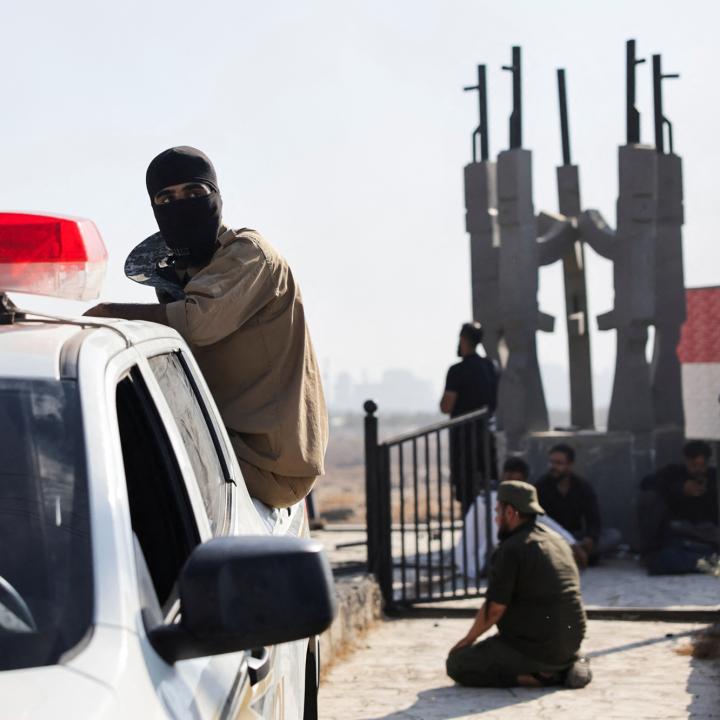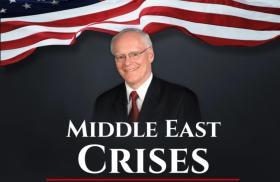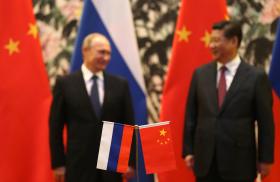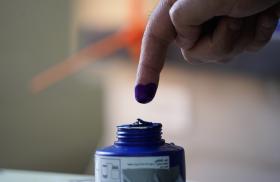
- Policy Analysis
- Fikra Forum
Implications of the Recent Violence in Suwayda

The violence in Suwayda has exposed the limits of Ahmed al-Sharaa’s control of Syria. But the assumption that the Druze community there is a monolith does not bear out: Damascus and Jerusalem are vying for influence amid the various leaders competing for power in the southwestern Syrian governorate.
Recent clashes in Syria’s Druze-majority governorate of Suwayda, which left more than 800 dead and 900 injured, mark a significant flashpoint in Syria’s governmental transition and its relations with minority communities. On July 11, armed Bedouin robbed a Druze vegetable seller along the Damascus-Suwayda highway, taking him prisoner, and other Druze then abducted a Sunni man in retaliation, setting off a spate of tit-for-tat kidnappings that soon escalated into fierce clashes between Druze militias and Bedouin groups. What began as a local incident soon drew in government forces and tribal factions and led to Israeli airstrikes, dramatically expanding the conflict’s scope and reinforcing Druze fears about escalation and the threat of violence by government forces and their allies. It also confirmed Druze fears that Damascus will not protect them in the event of a clash, and cemented a division in the Druze leadership’s approach to Damascus.
Druze-Damascus Ties
Relations between the Druze leadership and the Syrian government have been fractious since the government led by Ahmed al-Sharaa took power in December 2024. Druze community leadership in Suwayda is concentrated in the mashayakh al-aql—the preeminent Druze spiritual body in Syria—whose members are Sheikhs Hikmat al-Hijri, Yousef al-Jerboa, and Hammoud al-Hinnawi. All three hail from prominent Druze families and inherited their positions from family members. Hijri is considered the most prominent sheikh due to his role as head of the “spiritual presidency,” which he inherited following his brother’s death in 2012. Jerboa and Hinnawi lead the Ain al-Zaman shrine, a significant religious landmark that offers educational and humanitarian services. Another important Druze figure in Suwayda, though not part of the mashayakh al-aql, is Laith al-Balous, who is also a member of a prominent Druze family and serves as leader of the al-Karama Guesthouse faction. His father, Wahid al-Balous, founded the prominent Rijal al-Karama armed faction and led efforts in Suwayda to oppose forced conscription into Bashar al-Assad’s army. He was killed in 2015, most likely by the regime.
After Assad was toppled, Druze leadership initially adopted a “wait and see approach,” with Hijri calling for a “comprehensive national conference” involving Syrians of “all spectra and colors.” Many Druze remained skeptical of Sharaa’s new government, remembering the massacres of Druze in Qalb Lawzah in 2015 by Jabhat al-Nusra—a predecessor of Sharaa’s Hayat Tahrir al-Sham, which took Damascus last December—and by the Islamic State in Suwayda in 2018, when more than 200 people were killed. More broadly, fears spread throughout the community that Syria’s new leaders view the Druze as apostates and therefore deserve to be killed. This sentiment intensified when government and allied armed factions actively participated in the mass killing of Alawites along the coast in March 2025 and the killing of Druze militia members in Jaramana, Ashrafiyat Sahnaya, and Suwayda in April 2025. Here, the central government proved unable or unwilling to stop them.
Divergent Views on Integration
As these fears grew and Sharaa’s vision of a centralized Syria emerged, Druze spiritual leaders have split in their approach to the government. While Sheikhs Hinnawi and Jerboa have continued hedging, they have demonstrated an interest in integration into a unified Syria and been relatively willing to engage with Damascus. Sheikh Hijri, on the other hand, has been pushing increasingly against the government, advocating for assistance to the Druze—from Israel, the United States, Saudi Arabia, and Jordan—and a decentralized approach to Syrian governance. His characterizations of Sharaa’s government have also become more critical, and prior to the most recent conflict, he called it “extremist in every sense of the word.” Meanwhile, Balous, as a high-profile Druze advocate for integration, has cemented his position as the government’s preferred interlocutor in Suwayda, and Sharaa has been holding high-level meetings with him since early this year.
Last month’s conflict cemented these divergent approaches among Druze leadership; the rapid escalation added to the already strong distrust many Druze felt toward Syria’s new rulers and their Sunni allies, and will likely shape Druze approaches to Damascus for the foreseeable future. That Druze militias fired on government forces when they arrived in Suwayda highlights that for many of the militias, such as the Hijri-supported Suwayda Military Council (SMC) and the unaffiliated Rijal al-Karama, the entry of government forces into Suwayda governorate crossed a red line.
In addition, the Defense Ministry dispatched a military contingent to Suwayda that included numerous foreign fighters, which the Druze saw as provocative, given the perception that these fighters are among the most hardline Islamists in the Syrian security forces. That notion was reinforced after foreign fighters took part in the killing of Alawites in March. The subsequent arrival of non-government forces to support the Bedouin likewise showed many Suwayda residents that Sharaa was unable or unwilling to control the behavior of these forces.
Though a fragile ceasefire still holds, the situation remains tense. The sectarian nature of the violence and the deep humanitarian needs in Suwayda will likely harden Druze reluctance to integrate into a unified Syria or surrender their arms, complicating President Sharaa’s goal of consolidating control over all of the country. In addition, the clashes have increased intra-Druze fissures, adding another obstacle to government efforts to integrate Suwayda. While many observers describe Suwayda dynamics in terms of pro-Hijri or pro-Balous factions, there is a wide middle ground of viewpoints on integration and how to engage with Syria’s new leaders. Rijal al-Karama, for example, has been open to participating in talks with Damascus, but it also defended Suwayda against Defense Ministry forces. As some analysts have noted, the need for consensus among the three mashayakh al-aql in Suwayda poses potential risks for Druze unity moving forward, especially given recent tensions. The opacity and complexity of decisionmaking by senior Druze—especially among the mashayakh al-aql—adds to the continued uncertainty about the Druze community’s approach to integration.
Moreover, while the mashayakh al-aql may rely on consensus-based decisionmaking in most matters, this has not been true in their responses to this conflict. Sheikh Hijri has rejected numerous ceasefires negotiated by other local factions to end the violence or facilitate the government’s humanitarian relief, and called for external aid to the Druze. Referring to Sharaa’s government, Hijri stated that “the mask has fallen from the face of this oppressive, tyrannical ruling gang.” Hijri may feel that his posturing was proven effective when Israel became involved in the conflict, striking targets from Suwayda to Damascus to protect the Druze minority against the Syrian government. He may now aim to capitalize on growing popular anger at the Bedouin and the government, boosting his influence within the Druze community and in negotiations with Damascus.
Sheikh Jerboa, the Syrian government’s main contact among Druze religious leaders during recent events in Suwayda, has accused Hijri of monopolizing the decisionmaking of Druze sheikhs in rejecting the ceasefire agreements. While this disagreement is rooted primarily in divergent views over engagement with the government, Jerboa may also see Hijri’s behavior as an attempt to dilute the influence of the other prominent Druze sheikhs, himself included. According to reports, Hijri attempted to do this in 2014, allegedly considering adding a “loyal ally” as a fourth member of the mashayakh al-aql to support his positions and counter the influence of Jerboa and Hinawi. Hijri reportedly dropped these efforts after pushback from local notables.
Meanwhile, Balous has maintained his prior stance as a Syrian Arab nationalist and has vocally rejected Israeli intervention, accusing Hijri of fomenting internal strife among the Druze and alluding to Hijri’s apparent closeness to Israel. Yet Balous’s support for the government in Damascus both during and after the conflict has seriously harmed his standing within Suwayda, and he has reportedly fled the governorate, possibly due to fear of assassination. The Suwayda Military Council (SMC), which is aligned with Hijri in advocating for U.S. and Israeli intervention to protect Syrian Druze, was formed by a military officer who defected from Assad’s forces in 2015 shortly after the regime fell. It allegedly killed a top Balous advisor during the recent clashes and desecrated the tomb of Balous’s slain father, making the recent violence all the more personal.
Another sign of Balous's weakened local position is that Rijal al-Karama, which was founded by Laith's father Wahid and of which Laith was a member until 2016, released a statement distancing itself from him. This was likely issued because of frequent media reports referring to Laith as the leader of the faction, an image Rijal al-Karama is clearly seeking to avoid, especially after it lost 50 fighters in clashes against government and Bedouin personnel. Notwithstanding, the Syrian government in continuing its association with Balous in Suwayda is banking on his strong family ties there and on common interests.
Support for Damascus Dampened by Sectarian Violence, Humanitarian Needs
Israel’s decision to intervene in Suwayda was driven by political and security considerations. Israel is home to a small but important Druze community that has been calling on the government to protect its Syrian coreligionists. Fearing the potential for another October 7–style attack from Syrian territory, Israel declared its intent to enforce the demilitarization of Syria south of Damascus. Its decision to strike near government buildings in Damascus pushed the Syrian government into de-escalation talks, highlighting Israel’s leverage over the Sharaa government and demonstrating that such an approach could be effective in the future in dealing with Damascus. In Suwayda, public sentiment seems to have hardened against the government in Damascus. More residents are calling for external intervention, including by Israel, to protect the Druze, as evidenced by recent demonstrations throughout Suwayda. As relations with Damascus worsen, openings are emerging for increased Israeli involvement in local affairs. That involvement, however, may lead to divergent outcomes. It could bolster the position of those within the Druze community that oppose integration with Damascus but could also taint that movement as a potential Israeli fifth column in the eyes of Syrian nationalist Druze and Syrian society at large.
Regardless of the Druze political approach to Damascus, the conflict is continuing to have a major impact on Suwayda’s residents. The humanitarian needs in Suwayda following the recent violence are staggering, and there is a risk of broader instability and spillover, including to the neighboring governorate of Deraa and across the border into Jordan. According to the UN Office for the Coordination of Humanitarian Affairs, at least 192,000 people were displaced, the majority within Suwayda, and at least 40,000 fled to Deraa. Significant shortages of electricity, food, and access to potable water remain. The Suwayda National Hospital has reportedly reached capacity, with corpses piling up outside. Medical personnel have expressed concern about the spread of disease due to hospital conditions. Meanwhile, Syrian government media reported early in the conflict that fuel could not be transported into Suwayda due to the tense security situation. Weeks later, severe fuel shortages still remain. Complicating these conditions is Hijri’s recent rejection of a Syrian government aid convoy as part of his opposition to deploying government forces to Suwayda. Initially, the Syrian Arab Red Crescent was the sole humanitarian aid organization allowed to enter the governorate and the first UN aid delegation arrived only on July 31.
There are signs that the highly sectarian and targeted nature of the recent violence, along with the resulting humanitarian needs, have caused significant portions of the Druze population to deepen their opposition to the new Syrian government—a serious blow to Sharaa’s goal of full integration of minority communities. During the attacks on the Druze, men’s mustaches, an important part of Druze cultural pride, were forcibly shaved off, and reports circulated that Druze were forced to crawl on their hands and knees and labeled as “pigs.”
Druze militias also engaged in sectarian targeting, with the SMC, for example, accused of killing scores of Bedouin. A photo posted on social media showed a Druze militiaman standing in front of the body of a Bedouin hanging from a bridge, while users online celebrated a video showing armed men transporting dead Bedouin troops on the hoods of their trucks. While Suwayda’s Druze and neighboring Bedouin had periods of tension in the past—due to disputes over land ownership and Druze accusations of Bedouin involvement in the Islamic State attacks in 2018—the recent violence has undoubtedly deepened inter-communal anxieties and anger.
The sectarian and targeted nature of the attacks, coupled with Suwayda’s dire humanitarian situation and the increased divisions among the Druze, will almost certainly hamper the government’s ability to court Druze support for full integration into the state. While it is difficult to assess public opinion, it appears that Druze opposition to the government in Damascus has increased. This can be seen not only in the pressure that pushed Balous to leave Suwayda and in Rijal al-Karama’s forceful rejection of Laith, but also in the growing civil society protest movement. It is calling out Sharaa’s government in light of the recent violence and is advancing calls for external assistance to the Druze. Media reports indicate that Israeli flags have even been displayed by demonstrators.
As anti-integration voices appear to be ascendant among Suwayda’s Druze, Damascus faces a serious challenge in its efforts to unify Syria. While Sharaa has made great progress in restoring Syria’s international standing, his inability to control its various militant factions may undo the diplomatic victories he has achieved so far.
Erik Yavorsky is a development assistant with The Washington Institute, having previously been a research assistant in the Institute’s Linda and Tony Rubin Program on Arab Politics.


